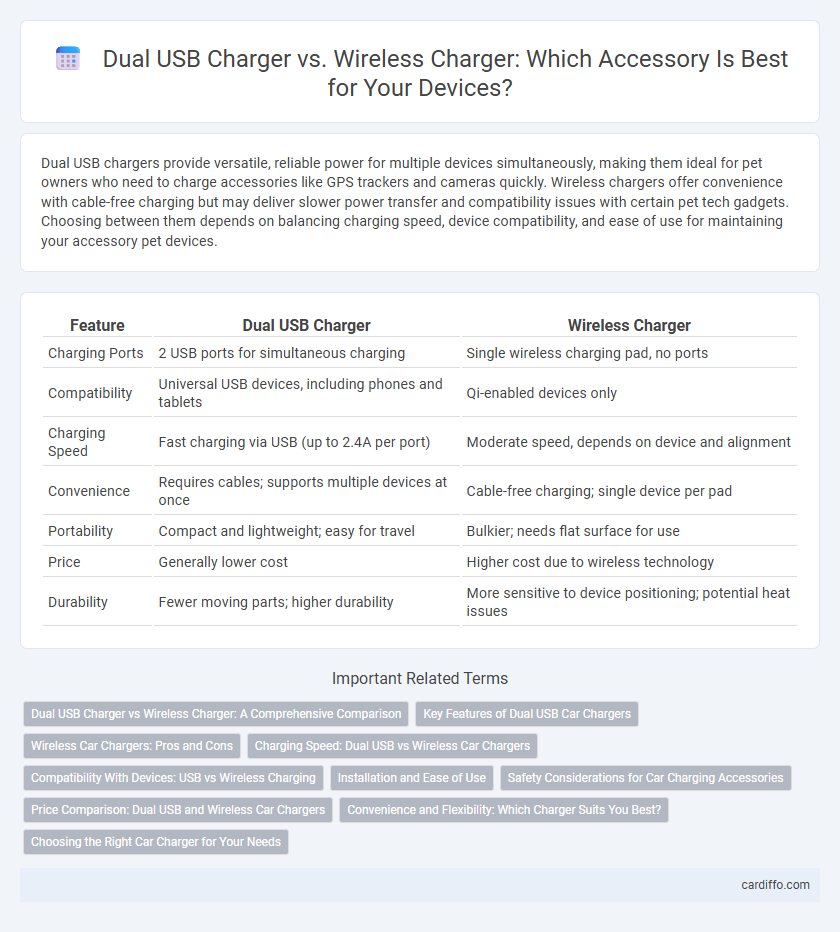Dual USB chargers provide versatile, reliable power for multiple devices simultaneously, making them ideal for pet owners who need to charge accessories like GPS trackers and cameras quickly. Wireless chargers offer convenience with cable-free charging but may deliver slower power transfer and compatibility issues with certain pet tech gadgets. Choosing between them depends on balancing charging speed, device compatibility, and ease of use for maintaining your accessory pet devices.
Table of Comparison
| Feature | Dual USB Charger | Wireless Charger |
|---|---|---|
| Charging Ports | 2 USB ports for simultaneous charging | Single wireless charging pad, no ports |
| Compatibility | Universal USB devices, including phones and tablets | Qi-enabled devices only |
| Charging Speed | Fast charging via USB (up to 2.4A per port) | Moderate speed, depends on device and alignment |
| Convenience | Requires cables; supports multiple devices at once | Cable-free charging; single device per pad |
| Portability | Compact and lightweight; easy for travel | Bulkier; needs flat surface for use |
| Price | Generally lower cost | Higher cost due to wireless technology |
| Durability | Fewer moving parts; higher durability | More sensitive to device positioning; potential heat issues |
Dual USB Charger vs Wireless Charger: A Comprehensive Comparison
Dual USB chargers provide simultaneous charging for multiple devices with faster power transfer efficiency compared to many wireless chargers, which often deliver slower charging speeds due to energy loss in wireless transmission. Wireless chargers offer convenience and compatibility with Qi-enabled devices, eliminating cable clutter but generally require precise device placement to maintain charging connectivity. Choosing between dual USB and wireless chargers depends on user priorities such as charging speed, device compatibility, and ease of use in daily accessory management.
Key Features of Dual USB Car Chargers
Dual USB car chargers feature two USB ports that enable simultaneous charging of multiple devices at high speeds, often supporting fast charging protocols like Qualcomm Quick Charge and USB Power Delivery. They are compact, easy to install, and compatible with a wide range of USB-powered devices such as smartphones, tablets, and GPS units. Unlike wireless chargers, dual USB chargers do not require device alignment and provide reliable charging performance even during driving.
Wireless Car Chargers: Pros and Cons
Wireless car chargers provide the convenience of cable-free charging and easy device placement, reducing wear on charging ports and enabling safer, hands-free phone use while driving. They often support fast charging for compatible smartphones and can integrate seamlessly with car dashboards or air vents for a sleek design. However, wireless chargers typically have slower charging speeds compared to dual USB chargers and may struggle with device alignment, while being less compatible with phones that lack wireless charging capabilities.
Charging Speed: Dual USB vs Wireless Car Chargers
Dual USB chargers provide faster charging speeds by delivering direct power to devices, often supporting up to 3.0 or 3.1 amp outputs per port for rapid energy transfer. Wireless chargers rely on inductive charging, which typically charges devices at slower rates, around 5 to 15 watts, depending on the model and compatibility. For quick recharging needs, dual USB chargers outperform wireless options in terms of charging efficiency and time.
Compatibility With Devices: USB vs Wireless Charging
Dual USB chargers offer broad compatibility, supporting multiple device types including smartphones, tablets, cameras, and other USB-powered gadgets through universal USB-A or USB-C ports. Wireless chargers utilize Qi technology, providing a cable-free charging experience compatible primarily with smartphones and accessories that have Qi-enabled receivers. Device compatibility hinges on port types and charging standards, with USB chargers offering versatility for older and non-Qi devices, while wireless chargers focus on convenience for Qi-certified modern electronics.
Installation and Ease of Use
Dual USB chargers require straightforward installation with minimal wiring, making them ideal for use in vehicles, desks, or wall outlets where multiple devices need simultaneous charging. Wireless chargers eliminate cable clutter and offer a convenient, plug-and-play experience but often require precise placement on a charging pad to function efficiently. Both options prioritize user accessibility, yet dual USB chargers provide more versatility for various device types without relying on compatible wireless charging technology.
Safety Considerations for Car Charging Accessories
Dual USB chargers with built-in overcurrent and short-circuit protection offer enhanced safety features for car charging, reducing risks of electrical damage and overheating. Wireless chargers rely on electromagnetic induction and often include temperature control mechanisms to prevent overheating, but their efficiency can decrease if the device or charger is misaligned. Choosing car charging accessories with certified safety standards such as UL or CE ensures reliable protection against electrical faults during use.
Price Comparison: Dual USB and Wireless Car Chargers
Dual USB chargers typically offer a lower price point averaging between $10 to $30, making them cost-effective for users needing simultaneous device charging with standard USB ports. Wireless car chargers, priced higher around $30 to $70, integrate Qi wireless technology, providing cable-free convenience but at an increased cost. Consumers prioritize budget constraints or advanced technology when comparing these car charger accessories for efficient in-vehicle device charging.
Convenience and Flexibility: Which Charger Suits You Best?
Dual USB chargers offer convenience by allowing simultaneous charging of multiple devices with universal compatibility, making them ideal for travel and workplaces. Wireless chargers provide flexibility and reduce cable clutter, supporting quick, cable-free charging for compatible smartphones and accessories. Choosing between the two depends on whether you prioritize multi-device charging capacity or the ease of cable-free charging.
Choosing the Right Car Charger for Your Needs
Dual USB chargers offer simultaneous charging for multiple devices with fast, reliable power output, making them ideal for users needing efficiency and versatility on the go. Wireless chargers provide the convenience of cable-free charging, compatible with Qi-enabled phones, reducing wear on charging ports and enhancing ease of use during short trips. Selecting the right car charger depends on your device compatibility, charging speed preferences, and whether you prioritize convenience or multiple device support.
Dual USB charger vs wireless charger Infographic

 cardiffo.com
cardiffo.com